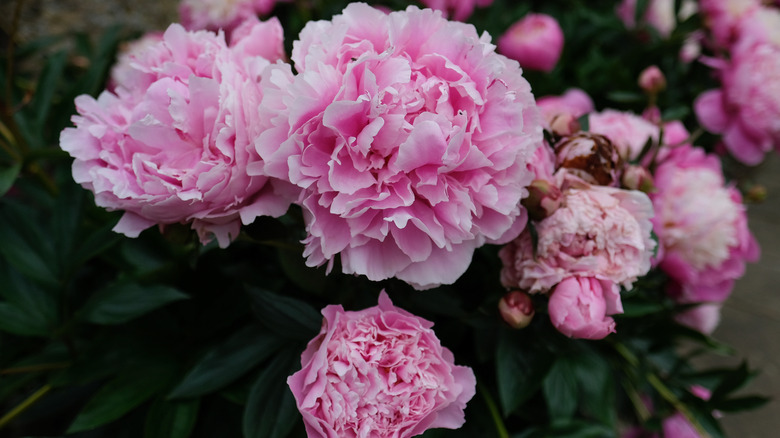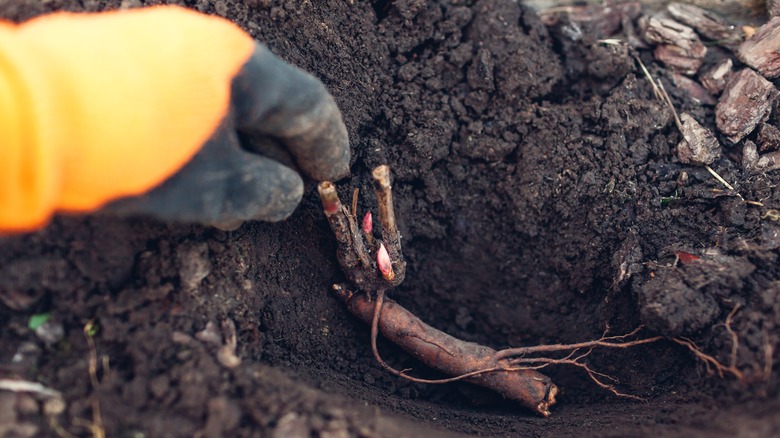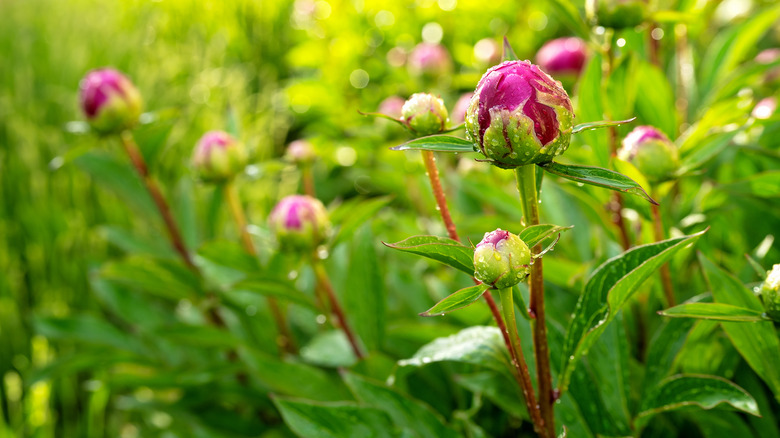Can You Plant Peonies In The Spring? Our Professional Gardener Weighs In
Peonies are one of spring's most anticipated flowers. They start pushing up their shoots in late April, and by mid-May their buds are getting ready to burst forth into blooms that last for several weeks. Normally, peonies are planted in late summer or autumn, when other spring-blooming perennials are planted. Generally speaking, it's not a good idea to plant peonies in spring, even if you acquire a potted one. It's best to wait until their flowering period has ended to plant them.
The main reason that springtime isn't optimal for planting peonies is that these long-lived, winter-hardy perennials have the most intense period of their growing season in spring when they form large buds and put forth their famously beautiful flowers. Planting flowering perennials during the active part of their growth cycle can weaken or cause injury to the plant. Therefore, a good rule of thumb is to plant long-lived perennials like peonies either before buds form, or when they have finished flowering for the season.
The exception to this rule for peonies is a bare root peony, which many gardeners purchase from mail-order catalogs or websites. These can be planted as soon as received, as it will take time for the root to grow into a plant of mature size that will flower. If you acquire a potted peony from a garden shop or as a gift in the springtime, it's best to wait until it has stopped flowering to plant it in your garden.
When to plant bare root peonies
Peonies are very long-lived, but it may take several years for a bare root peony to get established and start producing flowers every year. Most bare root peonies will have several "eyes" (pink or white buds) that grow upwards from the tuberous root. The more eyes that are present, the faster the peony will reach maturity and start producing flowers each spring. Plant in late summer or autumn to give the peony plenty of time to get acclimated to its new spot.
Plant the bare roots in a good spot where they will have some room to spread out a bit. Choose a location with fertile, well-draining soil and add a bit of compost. Peonies need plenty of direct sunlight to help them get established and thrive for years to come. Be sure not to plant them too deep (no more than two inches between the eyes and the soil surface), or your peonies may not bloom properly.
Normally, after planting a bare root peony, you will get a plant with leaves the following season, but maybe not buds. Within two years, buds should start to form each spring and give you flowers, which will increase each year as the plant gets bigger. The buds may be somewhat small until the plant is at least three years old. Be patient, as your peony can live to be a hundred years old once it gets off to a good, healthy start.
What happens if you plant peonies in spring?
The quick answer is: it depends. If a peony already has buds formed, digging it up or planting it will stress the plant, which may affect whether those flowers open or not. If it is already flowering, the petals may drop off quicker than normal due to the stress of being planted. The peony should survive, but it may take a year or two to start thriving in its new spot.
We can't always control the timing of planting in our gardens. Years ago, a neighborhood tree was being cut down (a gorgeous ornamental cherry that I was told was "diseased") to make room for a fence. A perennial garden was about to be destroyed by a small bulldozer. So I rushed over, in cold spring rain, still wearing slippers, and asked if I could have the plants. There were peonies, irises, and roses. I refused to let them go to waste just because it wasn't the proper planting time. So I rescued them, and after a bit of a rough start, they were fine.
Peonies don't like to be "disturbed," so dividing them is best done when the plant is dormant, in early autumn. If you move them carefully, your peony may not miss a season of spring bloom. But it's very normal for a peony to fail to produce flowers for a year after being divided and moved. It should be back to its normal schedule the following spring.


